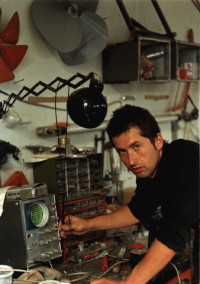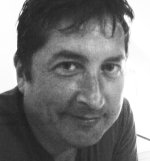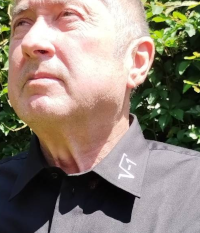fx 1989,
2007, 2024



Francine Xavier (born 1956, Linz)
Studied "Visual Communication" at the Academy of Applied Arts. He worked as an assistant to Prof. Peter Weibel and taught computer languages, audiovisual production, electronics, and electrical engineering at the same academy until 1992. He also taught communication theory at the Institute of Architecture at Graz University of Technology. Xavier has participated in numerous exhibitions, including Ars Electronica, Aperto Biennale di Venezia, Triennale Milano, and the Art and Exhibition Hall in Bonn, Germany.
He works at the intersection of art and technology, with a particular focus on disruptions and "glitches" in the fields of art, mathematics, and physics, always incorporating a social component into his work. In the late 1980s, Xavier began integrating the electromagnetic realm into art installations using geostationary weather satellites, which were presented at the Neue Galerie Graz in 1989 and the Aperto at the Venice Biennale in 1990. By operating various antennas and radio telescopes, he transformed vibrations into form, expanding his space-time installations in the spirit of Marshall McLuhan.
With the rise of the open-source and free software community in the mid-1990s, Xavier engaged in the emerging hacker culture, marking a shift from the media art context of the 1980s to a new network culture. He worked with the Silverserver network and initiated the free citizen radio network Funkfeuer.at in Vienna and Graz. From 2004 to 2007, he ran his "Media Art Lab" at the Kunsthaus Graz, where the "Data-Spind" housed 60 internet servers belonging to artists and net culture activists within a locker sculpture. The space also hosted numerous events that fostered local social engagement.
Since 2008, he has been working again with the Stadtwerkstatt Linz, with which he had collaborated in the late 1980s in media art. He launched an "Artist in Residence" program on the art ship Eleonore and founded the "Infolab" at the Stadtwerkstatt, aiming to critically examine our information society and promote a human component in it. Xavier advocates for a new method where information should only be processed in a complex manner, symbolized by the square root of minus one.
More Information:
http://kunstlabor.at
http://halfbit.org
short impression / work 85-95
credits:
End 80ties:
Armin Medosch, Peter Weibel, Ruth Schnell, Verena Formanek, Leo Schatzl.
STWST around 1992:
Gotthard Wagner, Tomi Lehner, Georg Ritter, Markus Binder, Gabi Kepplinger
Kunstlabor 1995:
Oskar Obereder, Max Kossatz, FE Rakuschan
Silverserver:
Chris Mutter, Franz Schaefer, Andrea Mair,
Funkfeuer:
Team Teichenberg, Aaron Kaplan, Roland Jankowski
MKL Graz:
Armin Medosch, Klaus Knopper, knoppix.at (Duesseldorf, Germany); TuringTrainTerminal
Severin Hofmann, Udo Wid, David Moises (Wien, Austria); Jaromil - dyne.org
(Amsterdam, Netherland); girl.tv (Hamburg, Germany); HIVE Networks,
(London, England); kuda.org - (Novi Sad, Serbia); Tim Boykett -
(Perth/LInz , Australia/Austria); Steim - (Amsterdam, Netherland); Sven
Guckes (Berlin, Germany), Rama Cosentino (Barcelona, Spain); 1st
pd-convention (with Miller Puckette, USA and ca 30 other developers
from all around the world).
STWST aroung 2008:
Chris Eder, Armin Medosch, Olivia Schütz


